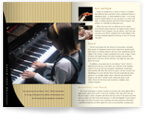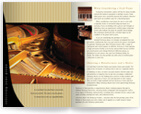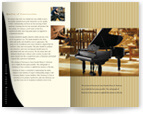Choosing the right piano…

How a piano works
When a player’s finger strikes a key, it sets the key action (a series of levers connected to a felt hammer) in motion. The hammer strikes a metal string, or a combination of metal strings, which causes them to vibrate. These vibrations are transmitted from the strings to the soundboard through bass and treble bridges, and the soundboard converts the vibrations into what is known as piano tone. It also amplifies the notes so that they can be heard. There are over 12,000 specific parts in the typical piano, all of which must function with ease and accuracy to produce the music we love.




The size of the room where the piano will be placed is an important consideration. Sound quality and volume are directly related to the size of the piano’s soundboard and the length of its strings. Therefore, the larger the piano, the better it will sound. But make no mistake: a high-quality upright is a better choice than a low-quality grand.
The major difference between an upright and a grand piano, other than looks and size, is the position of the soundboard. In a grand piano, the soundboard and strings are positioned horizontally; in an upright piano, they are positioned vertically. Thus, in a grand piano the action works with gravity and is more responsive than an upright.
Servicing your piano
Routine service is an important part of piano ownership. There are three basic steps in maintaining the sound of your piano: tuning, which brings the piano back to pitch; voicing, which affects the piano’s tone; and regulation, the adjustment of the action mechanism which affects the touch of the piano.
Tuning and voicing are different aspects of adjusting the piano to its optimum standard of performance. Tuning is the adjustment of the piano’s strings to the correct pitch. Voicing is the adjustment of the piano’s tone or sound and is done by softening or hardening the hammers and adjusting various parts of the piano’s keyboard mechanism. Regardless of its original voicing, every piano will acquire a somewhat brighter tone with time as the hammer felts become compacted the more they are struck against the strings.

